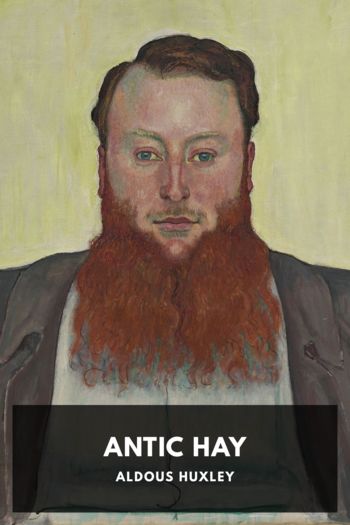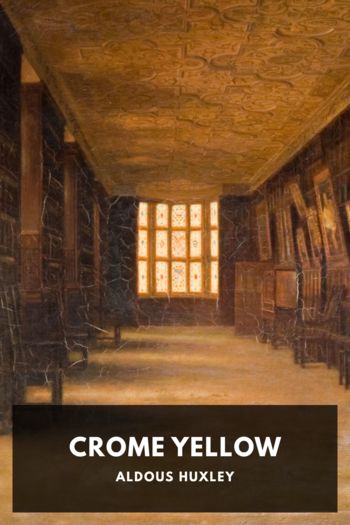Antic Hay Aldous Huxley (philippa perry book .TXT) 📖

- Author: Aldous Huxley
Book online «Antic Hay Aldous Huxley (philippa perry book .TXT) 📖». Author Aldous Huxley
Ranged round the Piazza are the Goldsmiths’ Hall, the Office of Excise, the Mint, the Post Office. Their flanks are curved to the curve of the ellipse. Between pilasters, their windows look out on to the Exchange, and the sister statues on the balustrades beckon to one another across the intervening space.
Two master roads of ninety feet from wall to wall run westwards from the Exchange. New Gate ends the more northern vista with an Arch of Triumph, whose three openings are deep, shadowy and solemn as the entries of caverns. The Guildhall and the halls of the twelve City Companies in their livery of rose-red brick, with their lacings of white stone at the coigns and round the windows, lend to the street an air of domestic and comfortable splendour. And every two or three hundred paces the line of the houses is broken, and in the indentation of a square recess there rises, conspicuous and insular, the fantastic tower of a parish church. Spire out of dome; octagon on octagon diminishing upwards; cylinder on cylinder; round lanterns, lanterns of many sides; towers with airy pinnacles; clusters of pillars linked by incurving cornices, and above them, four more clusters and above once more; square towers pierced with pointed windows; spires uplifted on flying buttresses; spires bulbous at the base—the multitude of them beckons, familiar and friendly, on the sky. From the other shore, or sliding along the quiet river, you see them all, you tell over their names; and the great dome swells up in the midst overtopping them all.
The dome of St. Paul’s.
The other master street that goes westward from the Piazza of the Exchange slants down towards it. The houses are of brick, plain-faced and square, arcaded at the base, so that the shops stand back from the street and the pedestrian walks dry-shod under the harmonious succession of the vaultings. And there at the end of the street, at the base of a triangular space formed by the coming together of this with another master street that runs eastwards to Tower Hill, there stands the Cathedral. To the north of it is the Deanery and under the arcades are the booksellers’ shops.
From St. Paul’s the main road slopes down under the swaggering Italianate arches of Ludgate, past the wide lime-planted boulevards that run north and south within and without the city wall, to the edge of the Fleet Ditch—widened now into a noble canal, on whose paved banks the barges unload their freights of country stuff—leaps it on a single flying arch to climb again to a round circus, a little to the east of Temple Bar, from which, in a pair of diagonally superimposed crosses, eight roads radiate: three northwards towards Holborn, three from the opposite arc towards the river, one eastward to the City, and one past Lincoln’s Inn Fields to the west. The piazza is all of brick and the houses that compose it are continuous above the ground-floor level; for the roads lead out under archways. To one who stands in the centre at the foot of the obelisk that commemorates the victory over the Dutch, it seems a smooth well of brickwork pierced by eight arched conduits at the base and diversified above by the three tiers of plain, unornamented windows.
Who shall describe all the fountains in the open places, all the statues and monuments? In the circus north of London Bridge, where the four roads come together, stands a pyramid of nymphs and Tritons—river goddesses of Polyolbion, sea-gods of the island beaches—bathing in a ceaseless tumble of white water. And here the city griffon spouts from its beak, the royal lion from between its jaws. St. George at the foot of the Cathedral rides down a dragon whose nostrils spout, not fire, but the clear water of the New River. In front of the India House, four elephants of black marble, endorsed with towers of white, blow through their upturned trunks the copious symbol of Eastern wealth. In the gardens of the Tower sits Charles the Second, enthroned among a troop of Muses, Cardinal Virtues, Graces and Hours. The tower of the Customs-House is a pharos. A great water-gate, the symbol of naval triumph, spans the Fleet at its junction with the Thames. The river is embanked from Blackfriars to the Tower, and at every twenty paces a grave stone angel looks out from the piers of the balustrade across the water. …
Gumbril Senior expounded his city with passion. He pointed to the model on the ground, he lifted his arms and turned up his eyes to suggest the size and splendour of his edifices. His hair blew wispily loose and fell into his eyes, and had to be brushed impatiently back again. He pulled at his beard; his spectacles flashed, as though they were living eyes. Looking at him, Gumbril Junior could imagine that he saw before him the passionate and gesticulating silhouette of one of those old shepherds who stand at the base of Piranesi’s ruins demonstrating obscurely the prodigious grandeur and the abjection of the human race.
XII“You? Is it you?” She seemed doubtful.
Gumbril nodded. “It’s me,” he reassured her. “I’ve shaved; that’s all.” He had left his beard in the top right-hand drawer of the chest of drawers, among the ties and the collars.
Emily looked at him judicially. “I like you better without it,” she decided at last. “You look nicer. Oh no, I don’t mean to say you weren’t nice before,” she hastened to add. “But—you know—gentler—” She hesitated. “It’s a silly word,” she said, “but there it is: sweeter.”
That was the unkindest cut of all. “Milder and more melancholy?” he suggested.
“Well, if you like to put it like that,” Emily agreed.
He took





Comments (0)